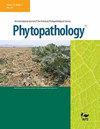求助PDF
{"title":"Unraveling <i>Pinus massoniana</i>'s Defense Mechanisms Against <i>Bursaphelenchus xylophilus</i> Under Aseptic Conditions: A Transcriptomic Analysis.","authors":"Jinghui Zhu, Kean-Jin Lim, Tianyu Fang, Chen Zhang, Jianren Ye, Li-Hua Zhu","doi":"10.1094/PHYTO-06-24-0180-R","DOIUrl":null,"url":null,"abstract":"<p><p>Pine wilt disease (PWD) is caused by the pine wood nematode (PWN, <i>Bursaphelenchus xylophilus</i>) and significantly impacts pine forest ecosystems globally. This study focuses on <i>Pinus massoniana</i>, an important timber and oleoresin resource in China, which is highly susceptible to PWN. However, the defense mechanism of pine trees in response to PWN remains unclear. Addressing the complexities of PWD, influenced by diverse factors such as bacteria, fungi, and environment, we established a reciprocal system between PWN and <i>P. massoniana</i> seedlings under aseptic conditions. Utilizing combined second- and third-generation sequencing technologies, we identified 3,718 differentially expressed genes post PWN infection. Transcript analysis highlighted the activation of defense mechanisms via stilbenes, salicylic acid and jasmonic acid pathways, terpene synthesis, and induction of pathogenesis-related proteins and resistance genes, predominantly at 72 h postinfection. Notably, terpene synthesis pathways, particularly the mevalonate pathway, were crucial in defense, suggesting their significance in <i>P. massoniana</i>'s response to PWN. This comprehensive transcriptome profiling offers insights into <i>P. massoniana</i>'s intricate defense strategies against PWN under aseptic conditions, laying a foundation for future functional analyses of key resistance genes. [Formula: see text] Copyright © 2024 The Author(s). This is an open access article distributed under the CC BY 4.0 International license.</p>","PeriodicalId":20410,"journal":{"name":"Phytopathology","volume":" ","pages":"2525-2535"},"PeriodicalIF":2.6000,"publicationDate":"2024-12-01","publicationTypes":"Journal Article","fieldsOfStudy":null,"isOpenAccess":false,"openAccessPdf":"","citationCount":"0","resultStr":null,"platform":"Semanticscholar","paperid":null,"PeriodicalName":"Phytopathology","FirstCategoryId":"97","ListUrlMain":"https://doi.org/10.1094/PHYTO-06-24-0180-R","RegionNum":2,"RegionCategory":"农林科学","ArticlePicture":[],"TitleCN":null,"AbstractTextCN":null,"PMCID":null,"EPubDate":"2024/12/16 0:00:00","PubModel":"Epub","JCR":"Q2","JCRName":"PLANT SCIENCES","Score":null,"Total":0}
引用次数: 0
引用
批量引用
Abstract
Pine wilt disease (PWD) is caused by the pine wood nematode (PWN, Bursaphelenchus xylophilus ) and significantly impacts pine forest ecosystems globally. This study focuses on Pinus massoniana , an important timber and oleoresin resource in China, which is highly susceptible to PWN. However, the defense mechanism of pine trees in response to PWN remains unclear. Addressing the complexities of PWD, influenced by diverse factors such as bacteria, fungi, and environment, we established a reciprocal system between PWN and P. massoniana seedlings under aseptic conditions. Utilizing combined second- and third-generation sequencing technologies, we identified 3,718 differentially expressed genes post PWN infection. Transcript analysis highlighted the activation of defense mechanisms via stilbenes, salicylic acid and jasmonic acid pathways, terpene synthesis, and induction of pathogenesis-related proteins and resistance genes, predominantly at 72 h postinfection. Notably, terpene synthesis pathways, particularly the mevalonate pathway, were crucial in defense, suggesting their significance in P. massoniana 's response to PWN. This comprehensive transcriptome profiling offers insights into P. massoniana 's intricate defense strategies against PWN under aseptic conditions, laying a foundation for future functional analyses of key resistance genes. [Formula: see text] Copyright © 2024 The Author(s). This is an open access article distributed under the CC BY 4.0 International license.
揭示无菌条件下 Pinus massoniana 对 Bursaphelenchus xylophilus 的防御机制:转录组分析
松树枯萎病(PWD)由松材线虫(PWN,Bursaphelenchus xylophilus)引起,对全球松林生态系统造成严重影响。本研究主要针对中国重要的木材和油脂资源--极易受 PWN 侵染的马尾松。然而,松树应对 PWN 的防御机制仍不清楚。针对PWD受细菌、真菌和环境等多种因素影响的复杂性,我们在无菌条件下建立了PWN和P. massoniana幼苗之间的互作系统。利用第二代和第三代联合测序技术,我们确定了 3,718 个 PWN 感染后的差异表达基因。转录分析强调了通过二苯乙烯、水杨酸和茉莉酸途径激活防御机制、萜烯合成以及诱导致病相关蛋白和抗性基因的作用,这些作用主要发生在感染后 72 小时。值得注意的是,萜烯合成途径,尤其是甲羟戊酸途径,在防御中起着关键作用,这表明它们在 P. massoniana 对 PWN 的反应中具有重要意义。这项全面的转录组分析深入揭示了P. massoniana在无菌条件下对PWN的复杂防御策略,为今后对关键抗性基因进行功能分析奠定了基础。
本文章由计算机程序翻译,如有差异,请以英文原文为准。

 求助内容:
求助内容: 应助结果提醒方式:
应助结果提醒方式:


